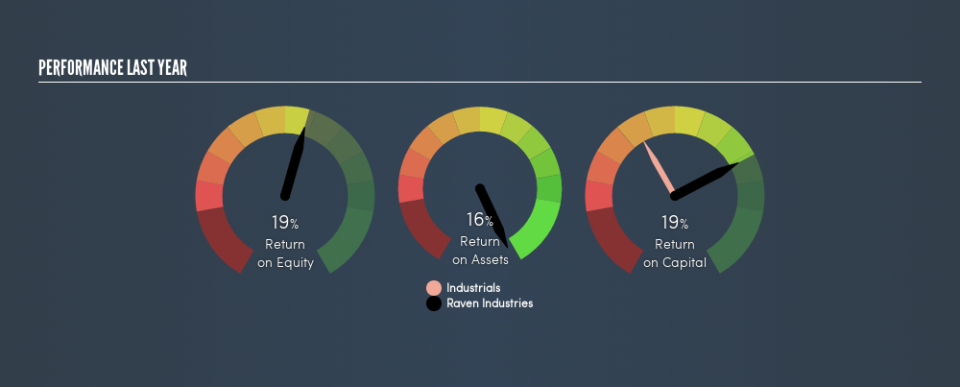Does Raven Industries, Inc. (NASDAQ:RAVN) Create Value For Shareholders?

Want to participate in a short research study? Help shape the future of investing tools and receive a $20 prize!
Today we’ll look at Raven Industries, Inc. (NASDAQ:RAVN) and reflect on its potential as an investment. Specifically, we’re going to calculate its Return On Capital Employed (ROCE), in the hopes of getting some insight into the business.
First of all, we’ll work out how to calculate ROCE. Then we’ll compare its ROCE to similar companies. Finally, we’ll look at how its current liabilities affect its ROCE.
Understanding Return On Capital Employed (ROCE)
ROCE is a metric for evaluating how much pre-tax income (in percentage terms) a company earns on the capital invested in its business. All else being equal, a better business will have a higher ROCE. Ultimately, it is a useful but imperfect metric. Renowned investment researcher Michael Mauboussin has suggested that a high ROCE can indicate that ‘one dollar invested in the company generates value of more than one dollar’.
How Do You Calculate Return On Capital Employed?
Analysts use this formula to calculate return on capital employed:
Return on Capital Employed = Earnings Before Interest and Tax (EBIT) ÷ (Total Assets – Current Liabilities)
Or for Raven Industries:
0.19 = US$60m ÷ (US$362m – US$35m) (Based on the trailing twelve months to October 2018.)
Therefore, Raven Industries has an ROCE of 19%.
View our latest analysis for Raven Industries
Is Raven Industries’s ROCE Good?
ROCE is commonly used for comparing the performance of similar businesses. It appears that Raven Industries’s ROCE is fairly close to the Industrials industry average of 19%. Regardless of where Raven Industries sits next to its industry, its ROCE in absolute terms appears satisfactory, and this company could be worth a closer look.
Our data shows that Raven Industries currently has an ROCE of 19%, compared to its ROCE of 8.4% 3 years ago. This makes us wonder if the company is improving.
It is important to remember that ROCE shows past performance, and is not necessarily predictive. ROCE can be misleading for companies in cyclical industries, with returns looking impressive during the boom times, but very weak during the busts. ROCE is only a point-in-time measure. What happens in the future is pretty important for investors, so we have prepared a free report on analyst forecasts for Raven Industries.
What Are Current Liabilities, And How Do They Affect Raven Industries’s ROCE?
Liabilities, such as supplier bills and bank overdrafts, are referred to as current liabilities if they need to be paid within 12 months. Due to the way the ROCE equation works, having large bills due in the near term can make it look as though a company has less capital employed, and thus a higher ROCE than usual. To counter this, investors can check if a company has high current liabilities relative to total assets.
Raven Industries has total assets of US$362m and current liabilities of US$35m. As a result, its current liabilities are equal to approximately 9.7% of its total assets. In addition to low current liabilities (making a negligible impact on ROCE), Raven Industries earns a sound return on capital employed.
What We Can Learn From Raven Industries’s ROCE
If it is able to keep this up, Raven Industries could be attractive. But note: Raven Industries may not be the best stock to buy. So take a peek at this free list of interesting companies with strong recent earnings growth (and a P/E ratio below 20).
If you like to buy stocks alongside management, then you might just love this free list of companies. (Hint: insiders have been buying them).
We aim to bring you long-term focused research analysis driven by fundamental data. Note that our analysis may not factor in the latest price-sensitive company announcements or qualitative material.
If you spot an error that warrants correction, please contact the editor at editorial-team@simplywallst.com. This article by Simply Wall St is general in nature. It does not constitute a recommendation to buy or sell any stock, and does not take account of your objectives, or your financial situation. Simply Wall St has no position in the stocks mentioned. Thank you for reading.

